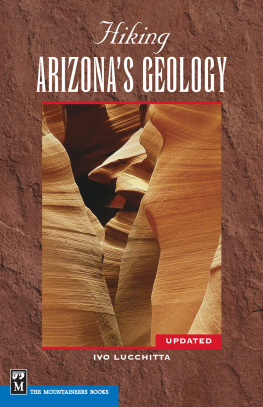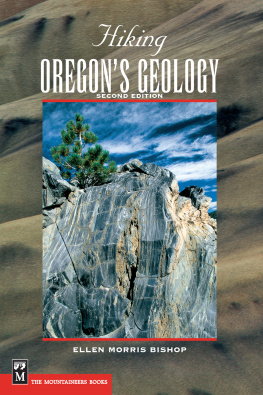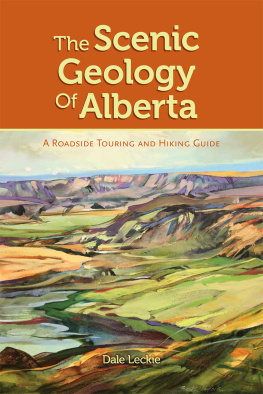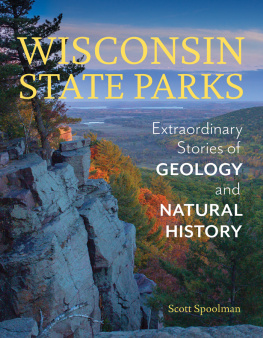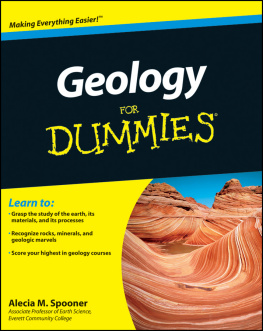

Hiking
ARIZONAS GEOLOGY
IVO LUCCHITTA

 | Published by
The Mountaineers Books
1001 SW Klickitat Way, Suite 201
Seattle, WA 98134 |
2001 by Ivo Lucchitta
All rights reserved
First edition: first printing 2001, second printing 2007, third printing 2012
No part of this book may be reproduced in any form, or by any electronic, mechanical, or other means, without permission in writing from the publisher.
Distributed in the United Kingdom by Cordee, www.cordee.co.uk
Manufactured in the United States of America
Acquiring Editor: Margaret Foster
Project Editor: Christine Ummel Hosler
Copy Editor: Kathy Walker
Production Coordinator: Dottie Martin
Series Cover and Book Design: The Mountaineers Books
Layout Artist: Jennifer LaRock Shontz
Cartographer and Illustrator: Jennifer LaRock Shontz
All photographs by the author unless otherwise noted
Cover photographs: Antelope Canyon, Arizona Jenny Hager/Adventure Photo Frontispiece: In the basin and range country. Photo by Ivo Lucchitta
Library of Congress Cataloging-in-Publication Data
Lucchitta, Ivo.
Hiking Arizonas geology / Ivo Lucchitta; [photographer, Ivo Lucchitta]. 1st ed.
p. cm.
Includes bibliographical references and index.
ISBN 0-89886-730-4
1. HikingArizonaGuidebooks. 2. GeologyArizonaGuidebooks. 3. ArizonaGuidebooks. I. Title.
GV199.42.A7 L83 2001
557.91dc21
2001003068
ISBN (paperback): 978-0-89886-730-5 ISBN (ebook): 978-1-59485-306-7 |  |
Contents


The mouth of the Grand Canyon
Preface
I have been a hiker all my life, disguised a good part of the time as a field geologist. All this hiking and walking has taught me a number of things. First, it beats the dismal rule that what is fun is bad for you, so this is a chance to have fun without paying some sinister penalty. Second, walking is the form of locomotion that best allows us to actually see and observe (there is a difference) and to hear what is around us. After all, we have evolved to interact with our surroundings at this kind of pace, which makes it possible to actually smell the flowers, the damp earth, the resin of the pines, and the sharp clean smell of the desert after a winter rain. All of which is more than can be claimed when careening about in or on some mechanical contraption.
Finally, the pleasure of hiking is enormously enhanced when the eyes are primed to observe and the brain is in gear, so that the natural surroundings begin to talk and display their inner workings, shyly at first, then almost exuberantly. This is what leads to inward cries of Eureka!, flashes of understanding whereby the minds eye discovers how the Earth today is the product of untold processes that came before. How todays parched desert, for example, may have been a warm shallow sea 600 million years ago, when life was busy inventing itself and exploding into an endless array of remarkable experiments. At that point, Earth, the underpinning of life, begins to talk.
This book, then, is aimed at those who like to have fun and who believe that walking is, in fact, great fun. It is also designed for those who know that the fun is greatly enhanced by having eyes and ears with which to see and hear the wonderful stories the Earth has to tell.

The Lees Ferry area
Acknowledgments
This is the place where it is customary to list all the people without whose help this book would have never been possible. I find it difficult to do it this way. Each of us, at any given time, is connected with and indebted to so many people that it becomes almost capricious to single out some at the expense of others. So I will try another tackthat of tracing the conceptual lineage of this book, from those spiritual forebears who long ago opened my eyes to the world of geology, to those who have had a direct impact on the book itself.
Robert P. Sharp, extraordinary teacher at Caltech, suddenly and forcefully introduced the world of geology into my consciousness at a time when I was preoccupied with physics. Sharps lectures and field trips made the world around me speak with clarity and elegance, revealing things that were never before imagined. There was no turning back.
Richard H. Jahns, my thesis professor, introduced me to the sheer delight to be found in craftsmanship and in asking the right questions, seeking the answers to these questions through careful observations in the field, and recording the results on those infinitely enticing pieces of paper called geologic maps.
Paul D. Krynine, endlessly eccentric and inscrutable to us graduate students, brought forth with relentless clarity the great Apollonian precept hidden under the clichs separating the wheat from the chaff and not losing the forest for the trees. This man taught us how to think.
Edwin D. McKee, the spirit of the Grand Canyon, showed me how to tackle large research projects, got me started in Grand Canyon research, and kindled a fascinated love for that amazing place that will last as long as I do.
Rowland Tabor brought about the meeting between The Mountaineers Books and me, leading to the interesting tango between publisher and author that is at the heart of any book.
Kevin Horstman helped in a great many ways, not forgetting the great hospitality that he and Cori Hoag gave to weary travelers.
Achim Gottwalds help during the final stages of proofreading was essential; without him, the job would not have been done on time.
My wife Baerbel, formidable geologist whose interests range from Antarctica to Mars, has been my companion on most of the hikes logged in this book, making observations, shoring up my flimsy memory, and generally acting as a nonsense filter. She has been indispensable.
Finally, Yuri, our polite and amiable but fiercely independent Siberian husky, has encouraged me to go when I would rather have stayed, even humoring me with great patience when I lingered entirely too long over some rock totally devoid of interesting smells.
In spite of this splendid help, responsibility for errors and omissions that may have crept into this book is mine alone.

View from Estes CanyonBull Pasture Trail, looking south into Mexico; tuff breccia can be seen on the right

